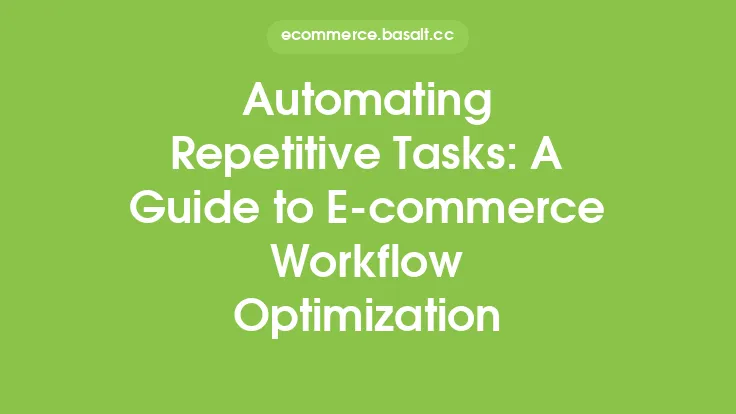Getting started with e-commerce automation can be a daunting task, especially for those who are new to the world of online selling. With so many different tools and platforms available, it can be difficult to know where to begin. However, by understanding the basics of e-commerce automation and how it can be used to optimize workflows, businesses can set themselves up for success and improve their overall efficiency.
Introduction to E-commerce Automation
E-commerce automation refers to the use of technology to automate repetitive and time-consuming tasks, such as order processing, inventory management, and customer service. By automating these tasks, businesses can free up more time to focus on higher-level activities, such as marketing and product development. E-commerce automation can be applied to a wide range of areas, including order fulfillment, shipping, and returns, as well as customer engagement and retention.
Understanding Workflow Optimization
Workflow optimization is the process of analyzing and improving the way that tasks are completed within an organization. In the context of e-commerce, workflow optimization involves identifying areas where automation can be used to streamline processes and improve efficiency. This can include tasks such as data entry, inventory tracking, and customer communication. By optimizing workflows, businesses can reduce the risk of errors, improve productivity, and provide a better customer experience.
Key Areas of E-commerce Automation
There are several key areas where e-commerce automation can be applied, including:
- Order management: Automating order processing, fulfillment, and shipping can help to improve the speed and accuracy of order delivery.
- Inventory management: Automating inventory tracking and management can help to prevent stockouts and overstocking, and ensure that products are always available when customers need them.
- Customer service: Automating customer service tasks, such as responding to common questions and resolving issues, can help to improve the customer experience and reduce the workload of customer service teams.
- Marketing and promotion: Automating marketing and promotional tasks, such as email marketing and social media posting, can help to improve the effectiveness of marketing campaigns and reduce the time spent on these activities.
Benefits of E-commerce Automation
The benefits of e-commerce automation are numerous, and can include:
- Improved efficiency: By automating repetitive and time-consuming tasks, businesses can free up more time to focus on higher-level activities.
- Increased accuracy: Automation can help to reduce the risk of errors, which can improve the overall quality of service and reduce the need for costly rework.
- Enhanced customer experience: By providing faster and more accurate order fulfillment, and improving communication with customers, businesses can improve the overall customer experience and increase customer loyalty.
- Cost savings: Automation can help to reduce labor costs, as well as the costs associated with errors and rework.
Choosing the Right E-commerce Automation Tools
With so many different e-commerce automation tools available, it can be difficult to know which ones to choose. When selecting automation tools, businesses should consider their specific needs and goals, as well as the level of integration required with existing systems. Some popular e-commerce automation tools include:
- Zapier: A platform that allows businesses to automate tasks and workflows by integrating different apps and services.
- Shopify Flow: A workflow automation tool that allows businesses to automate tasks and processes within the Shopify platform.
- Automate.io: A platform that allows businesses to automate tasks and workflows by integrating different apps and services.
Implementing E-commerce Automation
Implementing e-commerce automation requires careful planning and execution. Businesses should start by identifying areas where automation can be applied, and then selecting the tools and platforms that best meet their needs. It's also important to test and refine automated workflows to ensure that they are working as intended, and to provide training and support to employees who will be using these systems.
Best Practices for E-commerce Automation
To get the most out of e-commerce automation, businesses should follow best practices such as:
- Starting small: Begin with a limited number of automated workflows and gradually expand to other areas of the business.
- Monitoring and evaluating: Regularly monitor and evaluate automated workflows to ensure that they are working as intended and making adjustments as needed.
- Providing training and support: Provide training and support to employees who will be using automated systems to ensure that they are able to use these systems effectively.
- Continuously improving: Continuously look for ways to improve and optimize automated workflows to ensure that they are aligned with the changing needs of the business.
Common Challenges and Limitations
While e-commerce automation can offer many benefits, there are also common challenges and limitations that businesses should be aware of. These can include:
- Integration issues: Integrating automated systems with existing platforms and tools can be challenging, and may require significant time and resources.
- Data quality issues: Poor data quality can limit the effectiveness of automated systems, and may require significant time and resources to resolve.
- Employee resistance: Employees may be resistant to change, and may require training and support to effectively use automated systems.
- Cost: Implementing e-commerce automation can require significant upfront investment, and may not be feasible for all businesses.
Future of E-commerce Automation
The future of e-commerce automation is exciting, with new technologies and platforms emerging all the time. Some of the trends that are expected to shape the future of e-commerce automation include:
- Artificial intelligence: AI is expected to play a major role in e-commerce automation, enabling businesses to automate more complex tasks and make more informed decisions.
- Machine learning: Machine learning is expected to enable businesses to automate tasks and processes that were previously thought to be impossible to automate.
- Internet of Things: The Internet of Things is expected to enable businesses to automate tasks and processes in new and innovative ways, such as using sensors and other devices to track inventory and shipments.
Conclusion
E-commerce automation is a powerful tool that can help businesses to improve their efficiency, accuracy, and customer experience. By understanding the basics of e-commerce automation and how it can be used to optimize workflows, businesses can set themselves up for success and improve their overall competitiveness. Whether you're just starting out or looking to take your e-commerce business to the next level, e-commerce automation is definitely worth considering.





